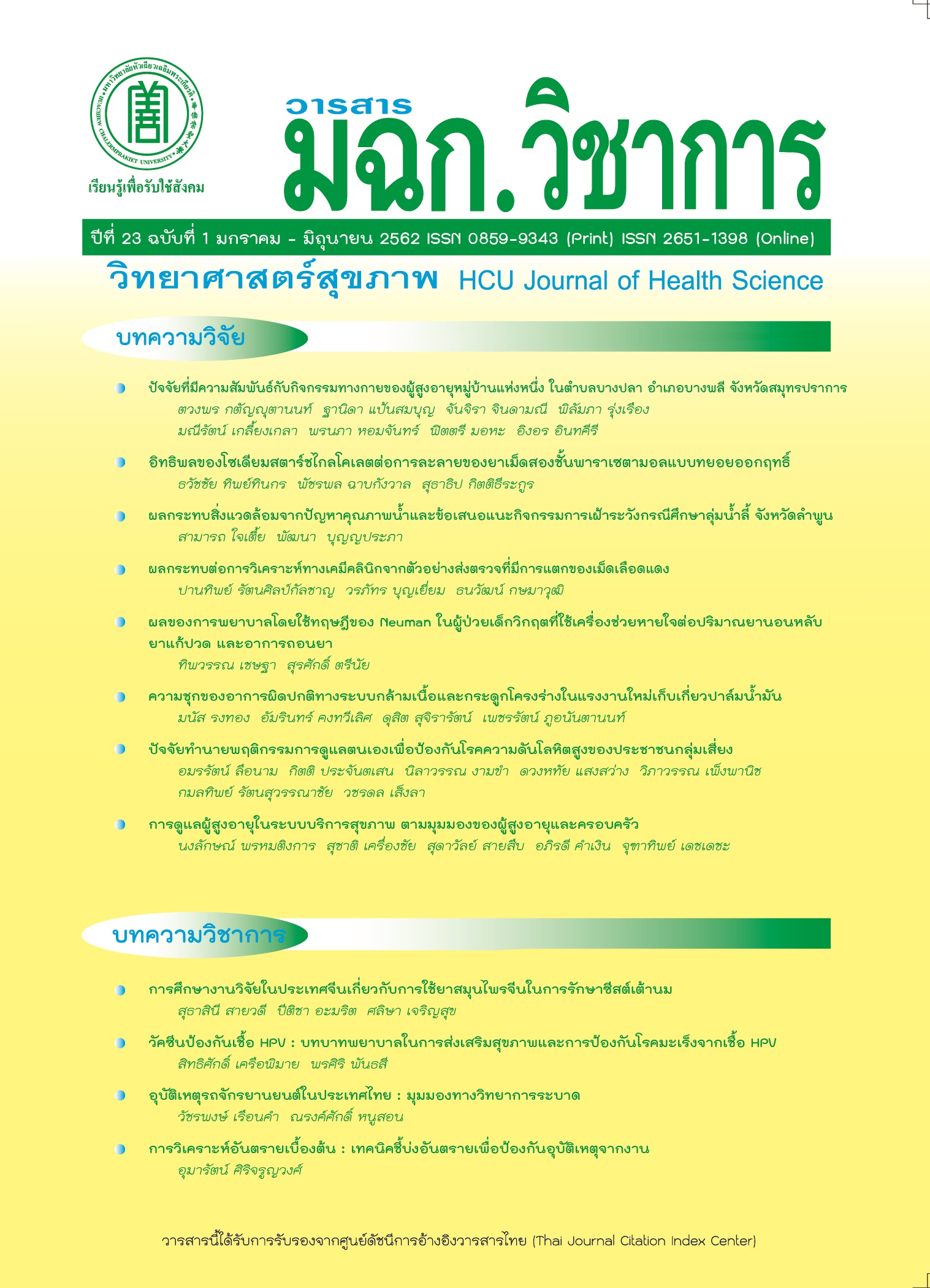ผลของการพยาบาลโดยใช้ทฤษฎีของ Neumanในผู้ป่วยเด็กวิกฤตที่ใช้เครื่องช่วยหายใจ ต่อปริมาณยานอนหลับ ยาแก้ปวด และอาการถอนยา
Keywords:
the Neuman model, respiratory failure in critically ill children, sedative, analgesic, drug withdrawal symptomsAbstract
The purpose of this quasi experimental research was to compare total dose of sedative, analgesic used and drug withdrawal symptoms between participants received the nursing intervention base on the Neuman model and the usual nursing care. The research subjects composed of 30 participants as inclusion criteria. We randomly assigned the participants into intervention group and control group. Research instruments used including 1) Experimental instrument was nursing care program base on Neuman model linked to the nursing intervention for preventing and reducing withdrawal symptoms including adminstration of sedative and analgesic drug, promotion of sleep, and comforting touch. 2) Data collecting instrument was Sophia Observation Withdrawal Scale. 3) Monitoring instruments were the nursing activities observation forms including 3.1) Adminstraion of drug for preventing and reducing drug withdrawal symptoms observation form.3.2) Teaching comforting touch to parents and caregivers with demonstraion method observation form 3.3) Promoting sleep observation form. These instruments were tested for content validity by five experts. Total dose of sedative, analgesic used were collected by researcher and drug withdrawal symptoms were collected by research assistants every eight hours. Data was analyzed by descriptive, Mann - whitney U test and repeated measures ANOVA.
The findings were as follows:total dose of sedative, analgesic used of critically ill children who received the nursing intervention base on the Neuman model was not different than that critically ill children who received the usual nursing care; and drug withdrawal symptoms of critically ill children who received the nursing intervention base on the Neuman model was significantly less than that of critically ill children received the usual nursing care at the level .05
Downloads
References
2. Anand KJ, Willson DF, Berger J, Harrison R, Meert KL, Zimmerman J, et al. Tolerance and withdrawal from prolonged opioid use in critically ill children. Pediatrics. 2010;125(5):e1208-e25.
3. Kudchadkar SR, Yaster M, Punjabi NM. Sedation, sleep promotion, and delirium screening practices in the care of mechanically ventilated children: a wake-up call for the pediatric critical care community. Crit Care Med. 2014;42(7):1592.
4. Rowe K, Fletcher S. Sedation in the intensive care unit. CONTINUING EDUCATION IN ANAESTHESIA, CRITICAL CARE & PAIN. 2008;8(2):50-5.
5. Macfarlane F. Paediatric anatomy and physiology and the basics of paediatric anaesthesia. London: association of anaesthesias; 2005.
6. Kress JP, Pohlman AS, O'Connor MF, Hall JB. Daily interruption of sedative infusions in critically ill patients undergoing mechanical ventilation. N Eng J Med. 2000;342(20):1471-7.
7. ณัฐวุธ สิบหมู่ ยุพิน สังวรินทะ. เภสัชวิทยา: เนื้อหาสำคัญและแบบฝึกหัด. กรุงเทพมหานคร: โฮลิสติกพับลิชชิ่ง; 2555
8. Ista E, te Beest H, van Rosmalen J, de Hoog M, Tibboel D, van Beusekom B, et al. Sophia Observation withdrawal symptoms-paediatric delirium scale: A tool for early screening of delirium in the PICU. Aust Crit Care. 2017;31(5)266-273.
9. Randolph AG, Wypij D, Venkataraman ST, Hanson JH, Gedeit RG, Meert KL, et al. Effect of mechanical ventilator weaning protocols on respiratory outcomes in infants and children: A randomized controlled trial. JAMA. 2002;288(20):2561-8.
10. Ista E, de Hoog M, Tibboel D, Duivenvoorden HJ, van Dijk M. Psychometric evaluation of the Sophia observation withdrawal symptoms scale in critically ill children. Pedr Crit Care Med. 2013;14(8):761-9.
11. Biswas AK, Feldman BL, Davis DH, Zintz EA. Myocardial ischemia as a result of severe benzodiazepine and opioid withdrawal. Clin Toxicol. 2005;43(3):207-9.
12. Sorce LR. Adverse responses: sedation, analgesia and neuromuscular blocking agents in critically ill children. Crit Care Nurs Clin North Am. 2005;17(4):441-50.
13. Neuman B, Fawcett J. The Neuman systems model. 4th ed. Upper Saddle River, NJ: Prentice Hall; 2002.
14. Poh YN, Poh PF, Buang SNH, Lee JH. Sedation guidelines, protocols, and algorithms in PICUs: a systematic review. Pediatr Crit Care Med. 2014;15(9):885-92.
15. Fuhrman BP, Zimmerman JJ, Clark RSB, Relvas M, T.Rotta A, Thompson AE, et al. Pediatric Critical Care. 5th ed. China: Elsevier,Inc; 2017.
16. Gleeson M, Timmins F. A review of the use and clinical effectiveness of touch as a nursing intervention. Clin Eff Nurs. 2005;9(1):69-77.
17. Henricson M, Berglund AL, Määttä S, Ekman R, Segesten K. The outcome of tactile touch on oxytocin in intensive care patients: a randomised controlled trial. J Clin Nurse. 2008;17(19):2624-33.
18. McCormack GL, Holsinger L. The significance of comforting touch to children with autism: Sensory processing Implications for occupational therapy. OJOT. 2016;4(2):4.
19. Burns N, Grove SK. The Practice of nursing research: Appraisal, synthesis, and generation of evidence. St. Louis, Mo: Saunders/Elsevier; 2009.
20. Ista E, van Dijk M, de Hoog M, Tibboel D, Duivenvoorden HJ. Construction of the Sophia Observation withdrawal symptoms-scale (SOS) for critically ill children. Intensive Care Med. 2009;35(6):1075-81.
21. Koo TK, Li MY. A Guideline of selecting and reporting intraclass correlation coefficients for reliability research. J Chiropr Med. 2016;15(2):155-63.
22. Jong Gt. Pediatric Development: Physiology. enzymes, drug metabolism, pharmacokinetics and pharmacodynamics. In: Bar-Shalom D, Rose K, editors. Pediatric Formulations: A roadmap. New York, NY: Springer New York. 2014;9-23.
23. Papaioannou V, Mebazaa A, Plaud B, Legrand M. ‘Chronomics’ in ICU: Circadian aspects of immune response and therapeutic perspectives in the critically ill. Intensive Car Med Exp. 2014;2(1):1.
24. Hu R-f, Jiang X-y, Zeng Y-m, Chen X-y, Zhang Y-h. Effects of earplugs and eye masks on nocturnal sleep, melatonin and cortisol in a simulated intensive care unit environment. Crit Care. 2010;14(2):1.
25. Le Guen M, Nicolas-Robin A, Lebard C, Arnulf I, Langeron O. Earplugs and eye masks vs routine care prevent sleep impairment in post-anaesthesia care unit: a randomized study. Bri J Anaesthesia. 2014;112(1):89-9.
Downloads
Published
How to Cite
Issue
Section
License
บทความที่ได้รับการตีพิมพ์เป็นลิขสิทธิ์ของวารสารวิทยาศาสตร์สุขภาพและสุขภาวะ
ข้อความที่ปรากฏในบทความแต่ละเรื่องในวารสารวิชาการเล่มนี้เป็นความคิดเห็นส่วนตัวของผู้เขียนแต่ละท่านไม่เกี่ยวข้องกับมหาวิทยาลัยหัวเฉียวเฉลิมพระเกียรติ และคณาจารย์ท่านอื่นๆในมหาวิทยาลัยฯ แต่อย่างใด ความรับผิดชอบองค์ประกอบทั้งหมดของบทความแต่ละเรื่องเป็นของผู้เขียนแต่ละท่าน หากมีความผิดพลาดใดๆ ผู้เขียนแต่ละท่านจะรับผิดชอบบทความของตนเองแต่ผู้เดียว




